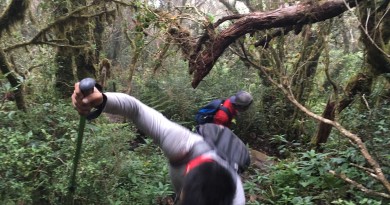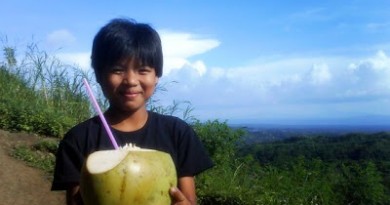Hypothermia in the tropics
 This is an article belonging to the ‘climb health‘ category in PinoyMountaineer. Information provided in this article are based on research and are not meant as a substitute to actual medical advice and healthcare.
This is an article belonging to the ‘climb health‘ category in PinoyMountaineer. Information provided in this article are based on research and are not meant as a substitute to actual medical advice and healthcare.
BACKGROUND
Hypothermia is a medical condition in which the body temperature falls. Being ‘warm-blooded’, our body has the mechanism to maintain a core body temperature, 37 degrees on the average. However, under extreme circumstances, the compensation our body does may not be enough. When temperature drops to 35 C, the diagnosis of hypothermia can be made. By extreme circumstances, one would think of snow and hailstorms, but actually even in the Philippines, hypothermia can occur. This article aims at a better understanding of this condition, and more importantly it focuses on how to recognize hypothermia, how to avoid it, and how to deal with it if it happens.
First, let’s take a look at the factors that cause hypothermia:
ENVIRONMENTAL FACTORS
Of course, the main determinant of hypothermia is the temperature. In general, for every 1000 meter altitude gain, there is a drop of 6 degrees celsius. In Mt. Pulag, temperatures can dip to 4-8 degrees. This is already very cold. Hypothermia is known to happen from 0-10 degrees. Take note that claims of subzero temperatures must always be taken with skepticism. This is because temperatures, even in the Cordilleras, hardly ever goes down to that level. Wristwatch thermometers and the like are not reliable measures of temperature.
But with strong winds, mountain climbers can actually feel what it’s like to have subzero temperatures. This is what is known as wind chill factor. Mountains with strong winds from the seas, such as Mt. Halcon and Mt. Guiting-Guiting, may not be very high (2000-2500 MASL) but the winds.
PERSONAL FACTORS
Certain conditions predispose a hiker to have hypothermia. If you are wet, then obviously you are most likely to feel the cold. Of course, if you are not used to cold weather, then you are more prone to be affected.
Importantly, alcohol is a risk factor for hypothermia. Intake of alcoholic beverages while on high elevation, while it gives you a feeling of warmth inside, actually increases the chances that you will have hypothermia.
SIGNS AND SYMPTOMS
Shivering is the first sign of hypothermia, which is actually an attempt of the body to gain heat. Slurred speech, abnormally slow breathing, and cold skin are also noted. Significantly, there would be some mental changes such as confusion, memory loss, and loss of coordination (“Hindi makapag-isip ng maayos”). Of course, these symptoms develop gradually, and because of the mental changes, the hypothermia sufferer may actually not realize that something’s wrong, or that he needs medical treatment.
PREVENTION
Careful planning is a must in any climb. In going for the Cordilleras or other high mountains, the presence of cold is already established; combined with rain it is a dangerous combination. Thus, if climbing during the rainy season, make sure your waterproofing is excellent. Aside from jackets, gloves, socks, scarves, bonnets are useful because the peripheral parts of the body are the most prone to cold.
Aside from elevation, consider also the location of the mountain in relation to the sea, as well as the presence of bodies of water. A mountain that is close to the sea like G2 or Halcon will, as I said, carry a bigger risk. Since getting wet is to be avoided,
Of course, all these clothing must be secure and dry, and thus the concept of waterproofing is of paramount importance. This will be discussed in greater detail on a ‘climb gear’ section of the blog.
FIRST AID
Immediately move the victim out of the cold, away from the winds, and out of water or moisture. This is common sense. In the mountains where moving the victim indoors may not be a possibility, at least make sure he is insulated from the ground, and replace wet clothing with dry ones.
Warm the patient, but don’t apply direct heat such as those coming from flames. Hypothermic parts of the body may have loss of sensation, and the skin can get burned without the victim feeling it. Body heat is beneficial, and when there is a general threat of hypothermia huddling together is a good way of offsetting the cold.
WHEN TO SEEK MEDICAL HELP
When severe symptoms, especially mental changes, appear and there is difficulty in breathing, then immediately take the patient to a hospital after administering first aid.
CONCLUSION
Hypothermia is a potentially dangerous medical condition, which hikers are at a risk of having when climbing in high altitudes and/or severe weather. Though rare, it is possible to have hypothermia even in the Philippines, where strong winds and moisture are predisposing factors. The usual dose of vigilance is recommended.






Leave a Reply
1 Comment on "Hypothermia in the tropics"
I have been reviewing the contents of my first aid kit, and there are several items I want to add in my list of first aid items. (I even have toothache drops and ammonia hehehe). Please give advice. Thanks.
1. Can chili powder help as cure for hypothermia? Is hypothermia just a brain-situation meaning “it’s all in your head?” If so, then eating spicy foods which tricks the brain into thinking that there is a rise in body temperature (which thereby makes the brain instruct the sweat glands to perspire) can compensate for the “it’s all in your head” lowering of temperature aka hypothermia?
2. Is there a “blood clotter”, “blood stopper”, or blood coagulating agents in cream or ointment form, that can be used in bloody limatik bites? I was told that there was a case where a victim’s wound stopped bleeding a day after, in contrast with the usual 30mins-1 hour bloody hell on limatik bites. I found Clotisol on the net, but I think it is manufactured for animals.
3. Is there a medication close to an antivenin (and can be packed in the FA kit) that can be used in snake bite victims aside from the usual first aid procedure in the outdoors? Or anything that can slack down the effects of the venom to give ample time in bringing the victim to the nearest hospital which have the antivenin?
PS:I found an article about hypothermia that clearly indicates DO NOT GIVE ALCOHOL to those affected. As explained, alcohol can make you feel warmth when in fact you are losing more heat to the environment faster than a hypothermic who was not administered with alcohol.
http://findmeacure.com/2008/06/24/hypothermia/
BPS